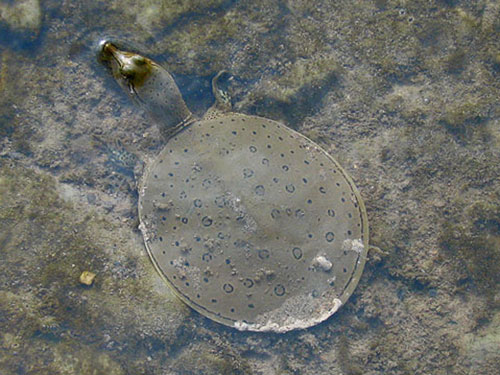Soft Shells
I sat on the edge of the jon boat balancing myself as I donned fins and a mask preparing to snorkel after my elusive quarry.
The setting was in a slow deep bend of the Savannah River on a sunny April Saturday. The plan was to capture a couple of softshell turtles that were basking on a log downriver. I would float with the current with just my head exposed and at the last moment, porpoise out of the water onto the unwary individuals. Since this technique had not been particularly effective in the past, I disguised my head and face with branches and Spanish moss to make my approach even more "stealthy." It took some time to convince my buddy William that this idea had merit but he eventually agreed to drop me off and then bring the boat down to pick me up after I snagged the turtles. I slipped quietly out of the boat and floated toward the turtles being especially careful not to disrupt the smooth water around me or dislodge my camouflage headgear.
Some of our state's wildlife species are pretty good at staying hidden, so you could easily spend your entire life here hunting, fishing or otherwise engaged in outdoor activities and never encounter certain creatures. The unusual-looking softshell turtle is one such beast. Although they are common residents of local streams and rivers and they get as big as trash can lids, they are rarely seen. Their flattened, streamlined bodies and flexible shells prompt the names "pancake" or "flapjack" turtles. Their huge oval, soft shells are masterfully camouflaged to match the bottoms of rivers, streams or lakes. A long neck and odd-looking snorkel nose allows them to breathe without surfacing.

Softshell turtles can also absorb oxygen from the water through vessels in the lining of their throats and other body parts, allowing them to remain under water for hours. The habit of burrowing under the sand or mud on the bottom of the wetland with just the head or snout exposed allows them to stay hidden. This technique facilitates the capture of crayfish, fish and other small animals by firing their long necks out from under the sand and grabbing prey. Softshells are powerful swimmers and are difficult for most predators to capture.
During the summer, softshells lay 10-30 eggs in neatly excavated holes in sandy areas near the water. They may even lay their eggs in a nearby alligator nest. Raccoons, foxes, skunks and other predators commonly prey on softshell nests so many eggs never have a chance to incubate. If the eggs survive, brightly patterned hatchlings emerge two to three months later. These little guys must remain hidden as much as possible because newly hatched turtles are an ideal size for predators. It may take ten years or more for softshells to reach adult size. Even as adults they fall prey to alligators, otters or other predators. A surprising number are killed on highways presumably as they cross roads to find suitable nesting sites. People occasionally catch snapping turtles, softshells and other species for the dinner table. I have even heard a couple of guys remark that a softshell turtle has seven kinds of meat. Now I am no culinary expert but try as I might, I cannot think of seven different kinds of meat, much less that many contained in one animal. I have never actually eaten a softshell turtle or plan to, so I won't say for sure but maybe they taste like pancakes.
Seven kinds of meat didn't cross my mind even once as I floated toward the turtles basking downstream. And to be sure, the turtles resting on a log in front of me did not whet my appetite in the least. By the time I got to within a hundred feet of the reptiles, three out of four had slipped off the logs and into the murky depths. As I drew closer the last animal cocked its head slightly and blasted off the perch and into the water leaving me empty handed and looking really silly in my cryptic attire (turtles 4, Tony 0).
Tags: herps